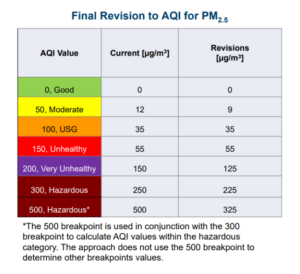Cambios en las reglas de materia particulada de la EPA
Publicación invitada de Clover Kagle, pasante de primavera de Clean Air
El 7 de febrero,la La EPA publicó una actualización de las pautas sobre los límites anuales de emisión de partículas PM2,5. El nuevo límite anual de 9.0 µg/m3 es una disminución de 25% del límite anterior, 12.0 µg/m3. La EPA basa la decisión en los requisitos de salud de la Ley de Aire Limpio y los Estándares Nacionales de Calidad del Aire Ambiental. (NAQS). La EPA afirma que las nuevas directrices ahorrarán más 4,500 vive en el próximo 8 años.
Sin embargo, Muchas agencias creen que las regulaciones más estrictas no van lo suficientemente lejos.. La OMS recomienda directriz de 5,0 µg/m3, y muchos otros países ya están aplicando esta directriz. La EPA no está cambiando ningún umbral secundario, Umbrales de PM10, o umbrales de PM2,5 de 24 horas. Los nuevos límites no afectan a la mayor parte de Estados Unidos, con solo 59 Los condados de todo el país necesitan reducir sus emisiones de PM2,5 para cumplir con las nuevas directrices..
Otro cambio en esta decisión son los niveles del índice de calidad del aire.. La EPA publicó el siguiente gráfico que muestra las revisiones de los niveles de seguridad sanitaria indicados por AQI. – tenga en cuenta que el umbral para “Moderado”, “muy poco saludable”, y “Peligroso” ahora son más bajos que los umbrales anteriores.
RSS 2.0 alimentar. Ambos comentarios y pings están actualmente cerrados.

